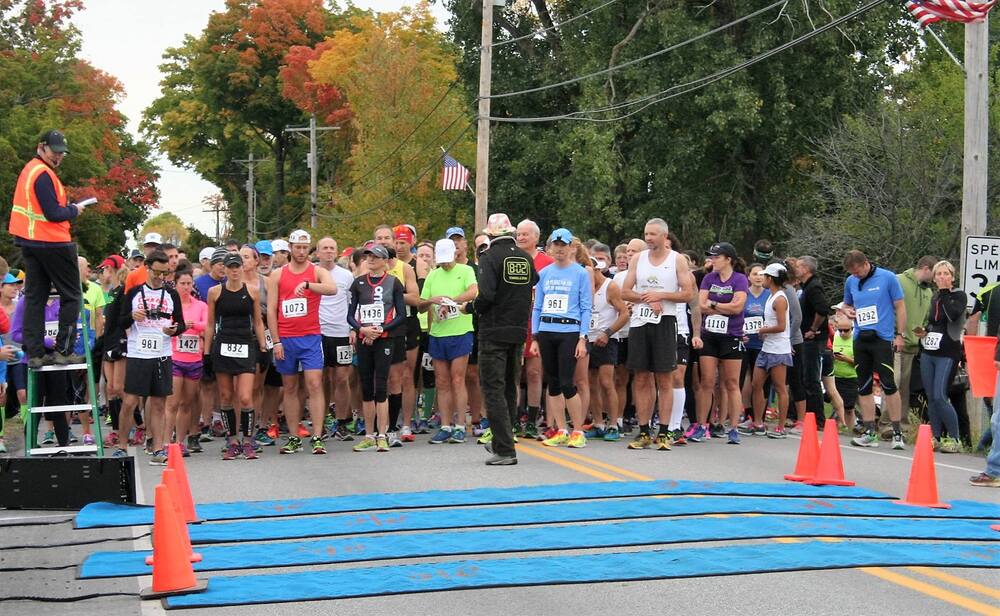This October will be the 35th running of the Green Mountain Marathon, a race that has metamorphosed over three decades, with four venue and three name changes. In its early years, it was called the Green Mountain Athletic Association Marathon. The race was held in October in Colchester on a two-loop course that included a jaunt through Winooski. From 1973-1977 it was still held in Colchester, but was changed to a five-loop course that included Lakeshore, Prim and Porter’s Point roads. In 1978 the race moved to South Hero in August and the name was changed to the Green Mountain Island Marathon. This scenic course circumnavigated the entire island and was held there from 1978-1985.
In 1986, the location was changed yet again, along with the date and name. Now it’s held in October, it’s called the Green Mountain Marathon, and the course is out-and-back on the west side of the island. Throughout its 35-year evolution, the Green Mountain Athletic Association sponsored the marathon, which explains the original name. Now it has the distinction of being the 59th-oldest marathon in the world, 32nd-oldest in the United States and 3rd oldest in New England.
Larry Kimball, of Burlington, started the race in 1971, just as the marathon distance was gaining recognition in the U.S. The following year, Frank Shorter won the Olympic Marathon in Munich. Many consider his win to be the reason marathons gained instant popularity in America. Soon, the Boston Marathon instituted qualifying races to control the number and quality of runners coming to Boston.
When Kimball established the Green Mountain Athletic Association Marathon, it was one of only three or four marathons in the Northeast, including Boston and NYC. The GMAAM course was awarded Boston qualifying status in 1975. “Even though it only attracted about 30 men each year, they were talented runners,” says Kimball. The inaugural year, Ralph Thomas of Maine won in 2:31:47. It wasn’t until 1974 that women entered the race. Women were always welcome, they just didn’t come. In 1975, Tim Tabor of Shelburne won in 2:50:20, running the last five miles barefoot.
In 1978, Ray Allen and Leighton Walker took over the race, moved it to South Hero and re-named it the Green Mountain Island Marathon. Apple orchard owner Ray Allen was a primary sponsor through his business, Allen Home Farm Markets. Although August is a hot time for a marathon, it was the best time for Allen because it’s still quiet in the apple orchard business.
“People came to South Hero because of the hospitality and the gorgeous coast. If you got too hot, you could jump in the lake. It was very laid back. No one took it super serious,” remembers Leighton Walker, who was the first president of the Green Mountain Athletic Association, founded in 1976, and is a former marathon runner. “It still goes by White Beach at mile 24, where everyone used to jump into the water. It wasn’t like anyone was trying to set any records,” he adds.
The Green Mountain Island Marathon drew over 200 people each year from 1978 to 1985. “It was a big-time marathon in the early 80s. It was like a second 4th of July on the island,” says Walker. “People would stand along the road with hoses as runners went by. It was a great time,” he adds. The Marathons peaked at 270 runners in 1982. The course record was set by Tibor Latincsics in 1981. His time was 2:24:46.
The island loop course took a lot of organization and volunteers to manage the traffic on Route 2, the main highway through the islands. As other marathons across the country sprang up and attracted large sponsors, the Green Mountain Island Marathon began to dwindle. Eventually race organizers deemed it necessary to confine the race to West Shore Road, the second half of the island loop. They also decided October was a better month, and since it would no longer encompass the entire island, they dropped Island from the name.
Howie and Nan Atherton of Huntington took over as race directors from 1986 to 2002. In order to increase attendance, they added a half marathon. It wasn’t long before the half marathon overshadowed the full marathon, with twice as many runners in the half marathon.
In 2004, when Jim Miller was named race director, the GMAA decided to eliminate the half marathon and focus on building marathon attendance by highlighting its history and genre.
“There are two completely different types of marathons,” says GMAA publicity director Steve Eustis. “Some attract big crowds, are high intensity, have tons of support, a big atmosphere and a downtown venue. There are many of that type of marathons in this country,” he says, citing the Vermont City Marathon held in Burlington over Memorial Day Weekend as an example. “The Green Mountain Marathon is of the other variety and is like running in the old days. We have rural roads, no traffic, not many spectators, and eight aid stations. A marathon of this type is more of a mind game. It’s a no-nonsense, low-cost, high quality, start-on-the-line, certified, Boston qualifying course. You can even sign up as late as the night before,” adds Eustis.
This year, the race is October 15. It starts at 8:30 a.m. at Folsom School, South Hero. The entry fee is $22 until October 1 and $27 thereafter and includes a t-shirt with race logo to all who make the early registration and a finisher’s medallion to all who make the distance. There is no race day registration and you must be 16 to participate. Top five men and top five women receive awards, as do the top three finishers in six age divisions, male and female. For more information, contact Jim Miller, gmm@gmaa.net or visit the GMAA web site at www.gmaa.net, where you’ll find information and application forms.

